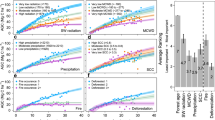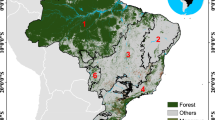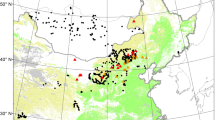Abstract
Brazil contains two-thirds of remaining Amazonian rainforests and is responsible for the most Amazon forest loss. Primary forest loss in the Brazilian Amazon has declined considerably since 2004 but secondary forest loss has never been quantified. We use a recently developed high-resolution land use/land cover dataset to track secondary forests in the Brazilian Amazon over 14 yr, providing the first estimates of secondary forest loss for the region. We find that secondary forest loss increased by (187 ± 48)% from 2008 to 2014. Moreover, the proportion of total forest loss accounted for by secondary forests rose from (37 ± 3)% in 2000 to (72 ± 5)% in 2014. The recent acceleration in secondary forests loss occurred across the entire region and was not driven simply by increasing secondary forest area but probably a conscious preferential shift towards clearance of a little-protected forest ecosystem (secondary forests). Our results suggest that secondary forests loss has eased deforestation pressure on primary forests. However, this has been at the expense of a lost carbon sequestration opportunity of 2.59–2.66 Pg C over our study period.
This is a preview of subscription content, access via your institution
Access options
Access Nature and 54 other Nature Portfolio journals
Get Nature+, our best-value online-access subscription
$29.99 / 30 days
cancel any time
Subscribe to this journal
Receive 12 digital issues and online access to articles
$119.00 per year
only $9.92 per issue
Buy this article
- Purchase on Springer Link
- Instant access to full article PDF
Prices may be subject to local taxes which are calculated during checkout




Similar content being viewed by others
Data availability
The data that support the findings of this study are available from the paper or from the supplementary materials. The TERRACLASS dataset used in current study is freely available from https://www.terraclass.gov.br/.
Code availability
The Google Earth Engine (GEE) codes analysed during current study are available in Y.W.’s GEE repository: https://code.earthengine.google.com/?accept_repo=users/wangyxtina/public
References
Dirzo, R. & Raven, P. H. Global state of biodiversity and loss. Annu. Rev. Environ. Resour. 28, 137–167 (2003).
Malhi, Y. et al. Exploring the likelihood and mechanism of a climate-change-induced dieback of the Amazon rainforest. Proc. Natl Acad. Sci. USA 106, 20610–20615 (2009).
Baccini, A. et al. Estimated carbon dioxide emissions from tropical deforestation improved by carbon-density maps. Nat. Clim. Change 2, 182–185 (2012).
Avitabile, V. et al. An integrated pan‐tropical biomass map using multiple reference datasets. Glob. Change Biol. 22, 1406–1420 (2016).
Spracklen, D. V., Arnold, S. R. & Taylor, C. Observations of increased tropical rainfall preceded by air passage over forests. Nature 489, 282–285 (2012).
Amazonia under Pressure (RAISG, 2012); https://go.nature.com/36ZOyvP
PRODES: Monitoramento de Floresta Amazonica Brasileira por Satelite (INPE, 2018); http://www.obt.inpe.br/prodes
Maia, H., Hargrave, J., Gómez, J. J. & Röper, M. Avaliação do Plano de Ação para Prevenção e Controle do Desmatamento na Amazônia Legal: PPCDAm: 2007-2010 (CEPAL, IPEA, GIZ, 2011); http://repositorio.ipea.gov.br/handle/11058/884
Assunção, J., Gandour, C. & Rocha, R. DETERring Deforestation in the Brazilian Amazon: Environmental Monitoring and Law Enforcement (Climate Policy Initiative, 2013).
Gibbs, H. K. et al. Brazil’s soy moratorium. Science 347, 377–378 (2015).
Rudorff, B. F. T. et al. The soy moratorium in the Amazon biome monitored by remote sensing images. Remote Sens. 3, 185–202 (2011).
Gibbs, H. K. et al. Did ranchers and slaughterhouses respond to zero‐deforestation agreements in the Brazilian Amazon? Conserv. Lett. 9, 32–42 (2016).
Massoca, P. E. D. S., Delaroche, M. & Lui, G. in Zero Deforestation: A Commitment to Change (eds Pasiecznik, N. & Herman Savenije, H.) 151–159 (Tropenbos International, 2017).
Almeida, C. Ad et al. High spatial resolution land use and land cover mapping of the Brazilian Legal Amazon in 2008 using Landsat-5/TM and MODIS data. Acta Amazonica 46, 291–302 (2016).
Poorter, L. et al. Biomass resilience of neotropical secondary forests. Nature 530, 211–214 (2016).
Chazdon, R. L. et al. Carbon sequestration potential of second-growth forest regeneration in the Latin American tropics. Sci. Adv. 2, e1501639 (2016).
Kato, O., Kato, M. d. S., Sa, T. d. A. & Figueiredo, R. Plantio direto na capoeira. Ciência e Ambiente 29, 99–111 (2004).
Carvalho, R., Adami, M., Amaral, S., Bezerra, F. G. & de Aguiar, A. P. D. Changes in secondary vegetation dynamics in a context of decreasing deforestation rates in Pará, Brazilian Amazon. Appl. Geogr. 106, 40–49 (2019).
Olofsson, P. et al. Good practices for estimating area and assessing accuracy of land change. Remote Sens. Environ. 148, 42–57 (2014).
Tyukavina, A. et al. Types and rates of forest disturbance in Brazilian Legal Amazon, 2000–2013. Sci. Adv. 3, e1601047 (2017).
Cordeiro, I. M. C. C., Rangel-Vasconcelos, L. G. T. & Schwartz, G. in Nordeste Paraense: Panorama Geral e Uso Sustentável das Florestas Secundárias (eds Cordeiro, I. M. C. C. et al.) 163–190 (EDUFRA, 2017).
Aguiar, A. P. D. et al. Land use change emission scenarios: anticipating a forest transition process in the Brazilian Amazon. Glob. Change Biol. 22, 1821–1840 (2016).
Vieira, I. C. G., Gardner, T., Ferreira, J., Lees, A. C. & Barlow, J. Challenges of governing second-growth forests: a case study from the Brazilian Amazonian State of Pará. Forests 5, 1737–1752 (2014).
Instrucao Normativa Sema No. 08, DE 28-10-2015 (Pará State, 2015); https://go.nature.com/2RptZ5p
Gibson, L. et al. Primary forests are irreplaceable for sustaining tropical biodiversity. Nature 478, 378–381 (2011).
Brockerhoff, E. G., Jactel, H., Parrotta, J. A., Quine, C. P. & Sayer, J. Plantation forests and biodiversity: oxymoron or opportunity? Biodivers. Conserv. 17, 925–951 (2008).
Lennox, G. D. et al. Second rate or a second chance? Assessing biomass and biodiversity recovery in regenerating Amazonian forests. Glob. Change Biol. 24, 5680–5694 (2018).
Martin, P. A., Newton, A. C. & Bullock, J. M. Carbon pools recover more quickly than plant biodiversity in tropical secondary forests. Proc. R. Soc. B 280, 20132236 (2013).
Nationally Determined Contributions (NDCs) (UNFCCC, 2015).
CO 2 Emissions (Metric Tons per Capita) (World Bank, 2014).
Correcting the PRODES Mask (INPE, 2017); https://go.nature.com/35PMghl
Olofsson, P., Foody, G. M., Stehman, S. V. & Woodcock, C. E. Making better use of accuracy data in land change studies: estimating accuracy and area and quantifying uncertainty using stratified estimation. Remote Sens. Environ. 129, 122–131 (2013).
Arévalo, P., Olofsson, P. & Woodcock, C. E. Continuous monitoring of land change activities and post-disturbance dynamics from Landsat time series: a test methodology for REDD+ reporting. Remote Sens. Environ. https://doi.org/10.1016/j.rse.2019.01.013 (2019).
Saah, D. et al. Collect Earth: an online tool for systematic reference data collection in land cover and use applications. Environ. Model. Softw. 118, 166–171 (2019).
Batterman, S. A. et al. Key role of symbiotic dinitrogen fixation in tropical forest secondary succession. Nature 502, 224–227 (2013).
Acknowledgements
This work was funded by a China Scholarship Council/University of Leeds grant to Y.W. (grant no. 201506300051), a Google Earth Engine Research Award (2016) to G.Z. and D.G., a NERC-funded standard grant to D.G. (TREMOR project grant no. NE/N004655/1), a Royal Society Newton Advanced Fellowship to M.A. (NAF/R1/180405) and a Horizon 2020 programme grant to G.Z. (ECOPOTENTIAL project grant no. 641762). We thank M.A., L. Santos and T. Lisboa for the contribution of visual interpretation of our sampling pixels. We thank the many dedicated staff at INPE and EMBRAPA who produce the PRODES and TERRACLASS products; these efforts are critical for understanding land use change dynamics in the Brazilian Amazon. We thank T. Baker and S. Batterman for providing useful feedback on an earlier version of the manuscript.
Author information
Authors and Affiliations
Contributions
Y.W., D.G. and G.Z. developed the concept and methodological work plan. Y.W. performed the data analysis with support from G.Z. and D.G. M.A., C.A.A., J.F.G.A., A.C.C., J.C.D.M.E. and A.R.G. coordinated the development of the TERRACLASS products. M.A. performed visual interpretation of the sampled pixels for sample-based estimates, with L. Santos and T. Lisboa (mentioned in Acknowledgements). Y.W., D.G. and G.Z. wrote the paper with contributions from M.A. All authors discussed results and commented on the manuscript.
Corresponding authors
Ethics declarations
Competing interests
The authors declare no competing interests.
Additional information
Publisher’s note Springer Nature remains neutral with regard to jurisdictional claims in published maps and institutional affiliations.
Supplementary information
Supplementary Information
Supplementary Figs. 1–4, Tables 1–12 and refs. 1 and 2.
Rights and permissions
About this article
Cite this article
Wang, Y., Ziv, G., Adami, M. et al. Upturn in secondary forest clearing buffers primary forest loss in the Brazilian Amazon. Nat Sustain 3, 290–295 (2020). https://doi.org/10.1038/s41893-019-0470-4
Received:
Accepted:
Published:
Issue Date:
DOI: https://doi.org/10.1038/s41893-019-0470-4
This article is cited by
-
Land use types determine environmental heterogeneity and aquatic insect diversity in Amazonian streams
Hydrobiologia (2024)
-
Assessment of forest cover changes using multi-temporal Landsat observation
Environment, Development and Sustainability (2023)
-
Dynamics of tropical forest regeneration in the Mexican Mesoamerican Biological Corridor from 2000 to 2020: does forest regeneration maintain continuous forest cover?
Regional Environmental Change (2022)
-
Large carbon sink potential of secondary forests in the Brazilian Amazon to mitigate climate change
Nature Communications (2021)
-
Expansion of soybean farming into deforested areas in the amazon biome: the role and impact of the soy moratorium
Sustainability Science (2021)



